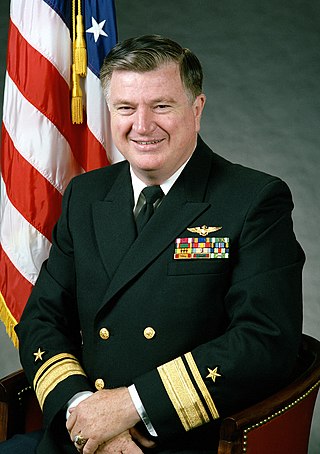
Wilson Falor "Bud" Flagg was a United States Navy Rear Admiral. On October 15, 1993, he was censured for failing to prevent the 1991 Tailhook conference scandal, effectively ending any chance for further career advancement. He and his wife Darlene were killed on board American Airlines Flight 77 during the September 11 attacks of 2001.

Jeremy Michael Boorda was a United States Navy admiral who served as the 25th Chief of Naval Operations. Boorda is notable as the first person to have risen from the enlisted ranks to become Chief of Naval Operations, the highest-ranking billet in the United States Navy.

Walter Marty Schirra Jr. was an American naval aviator, test pilot, and NASA astronaut. In 1959, he became one of the original seven astronauts chosen for Project Mercury, which was the United States' first effort to put human beings into space. On October 3, 1962, he flew the six-orbit, nine-hour, Mercury-Atlas 8 mission, in a spacecraft he nicknamed Sigma 7. At the time of his mission in Sigma 7, Schirra became the fifth American and ninth human to travel into space. In the two-man Gemini program, he achieved the first space rendezvous, station-keeping his Gemini 6A spacecraft within 1 foot (30 cm) of the sister Gemini 7 spacecraft in December 1965. In October 1968, he commanded Apollo 7, an 11-day low Earth orbit shakedown test of the three-man Apollo Command/Service Module and the first crewed launch for the Apollo program.
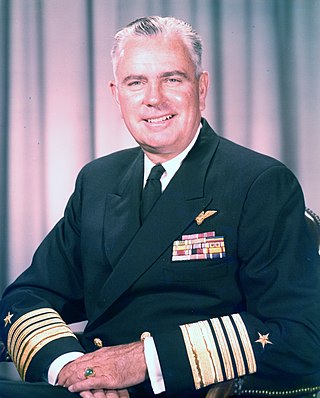
George Whelan Anderson Jr. was an admiral in the United States Navy and a diplomat. Serving as the Chief of Naval Operations between 1961 and 1963, he was in charge of the US blockade of Cuba during the 1962 Cuban Missile Crisis.

Strike Fighter Squadron 37 (VFA-37), also known as the "Ragin' Bulls", is a United States Navy F/A-18E Super Hornet fighter squadron stationed at Naval Air Station Oceana. They are a part of Carrier Air Wing 8 (CVW-8) and are attached to USS George H. W. Bush. Their radio callsign is Ragin' and their tail code is AJ.

Richard Chester Macke was a naval aviator and a former four-star admiral in the United States Navy. He last served as Commander of United States Pacific Command (USPACOM) from July 19, 1994, until January 31, 1996. After his navy career, Macke served as a vice president of Wheat International Communications Corporation.
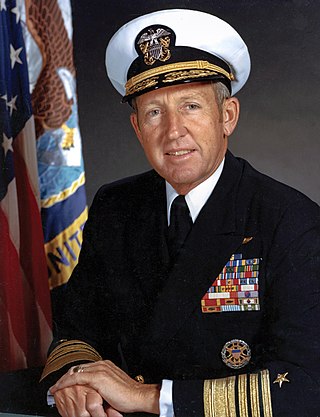
Admiral Thomas Bibb Hayward was Chief of Naval Operations for the United States Navy from July 1, 1978, until June 30, 1982, after which he retired from military service.

Roy Lee Johnson was a highly decorated four-star Admiral in the United States Navy. A Naval Academy graduate, he trained as Naval aviator and distinguished himself as Air Group Commander during several World War II campaigns.

John Crittenden Watson was an admiral of the United States Navy.

Robert Joseph Kelly is a retired United States Navy four star admiral who served as Commander in Chief, United States Pacific Fleet (CINCPACFLT) from 1991 to 1994.

Thomas McClelland is a decorated U.S. Navy veteran who served in the Vietnam War and Operation Desert Storm.

Admiral Richard Michael Dunleavy is a retired US naval officer. He retired as a two-star rear admiral in 1992 after being demoted from the rank of three-star vice admiral as a result of the Tailhook scandal.

Barbara Spyridon Pope was United States Assistant Secretary of the Navy from 1989 to 1993. She came to prominence during the Tailhook scandal for her opposition to the initial investigation conducted by Rear Admiral Duvall M. Williams, Jr., which she felt was a whitewash.
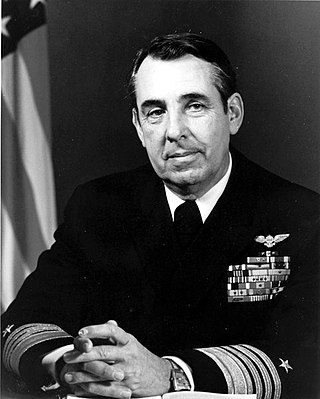
John Philip Weinel was an admiral in the United States Navy.

James Edward Service was a vice admiral of the United States Navy active during much of the Cold War. A naval aviator, he flew combat missions in the Korean War and Vietnam War, commanded aviation units and various ships including aircraft carriers, served as a test pilot, and was President of the Naval War College.
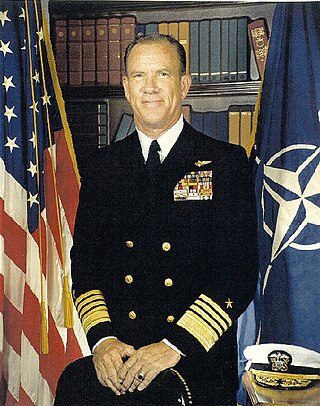
George Espy Ridgeway "Gus" Kinnear II was a four star admiral in the United States Navy who served as U.S. Military Representative, NATO Military Committee from 1981 to 1982. He was born in Mounds, Oklahoma. He attended George Washington University and Stanford University. Kinnear died on August 9, 2015, at the age of 87.
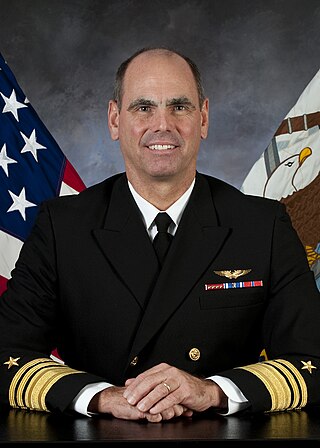
David H. Buss is a native of Lancaster, Pennsylvania and a retired vice admiral of the United States Navy. His last assignment was as Commander, Naval Air Forces and Commander, Naval Air Force, Pacific in San Diego, California, a position also known as the Navy's "Air Boss." Prior to taking command as the "Air Boss," Buss served as the Deputy Commander, United States Fleet Forces Command in Norfolk, Virginia. He also commanded Task Force 20, where he was responsible for training and certifying all Atlantic Fleet naval forces for overseas deployment. A career Naval Flight Officer, Buss served in multiple jet squadrons and staff assignments, and has commanded at every level of the navy from commander to vice admiral.

Ernest Eugene (Gene) Tissot Jr. was a United States Navy Rear Admiral and naval aviator who was highly decorated for his actions during the Korean War and the Vietnam War. He was born in Upland, California, and entered the Navy as a Naval Aviation Cadet in June 1945 and learned to fly in the Stearman N2S biplane at the Naval Air Station Livermore in August 1946. He was designated a Naval Aviator in June 1948 and commissioned as an Ensign that December. He was advanced in rank to Captain in January 1969 and his selection for the rank of Rear Admiral was approved by the President in March 1973.

Frederick Charles Turner was a highly decorated officer in the United States Navy with the rank of Vice admiral. Turner began his career as Reservist and Naval aviator during World War II and distinguished himself during Battles of Iwo Jima and Okinawa in early 1945. Following the War, Turner remained in the Navy and commanded aircraft carrier USS America during Vietnam War.

Robert Francis "Dutch" Schoultz was a vice admiral in the United States Navy. He was a former commander of the Naval Air Force U.S. Pacific Fleet and a former Deputy Commander in Chief of U.S. Naval Forces Europe/U.S. Commander Eastern Atlantic. He also served as Deputy Chief of Naval Operations for Air Warfare. From June 26, 1981 until his retirement on February 17, 1987, he was U.S. naval aviation's Gray Eagle, the second longest serving senior active-duty naval aviator. In retirement he became president of Rosco, Inc., an aerospace industry consulting firm, and served on the board of Reflectone Inc.




















